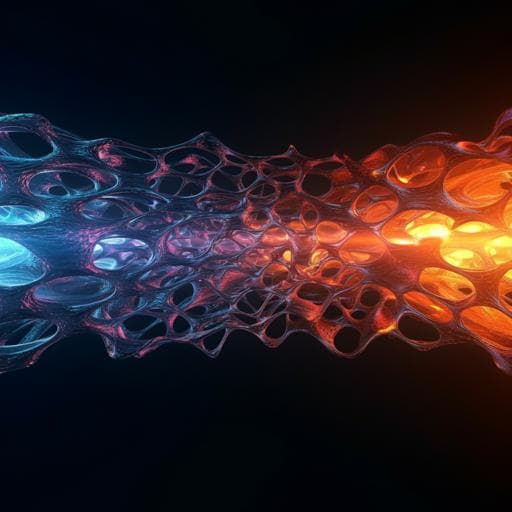
Physics
Magnetic-field-induced insulator-metal transition in W-doped VO₂ at 500 T
Y. H. Matsuda, D. Nakamura, et al.
This groundbreaking research explores the metal-insulator transition in tungsten-doped vanadium dioxide, revealing how an ultrahigh magnetic field can induce a metallic state in the insulating phase. Conducted by Yasuhiro H. Matsuda and colleagues, this study challenges conventional understandings by suggesting that structural instability drives the transition more than electron correlation.
~3 min • Beginner • English
Introduction
The study addresses the longstanding question of what drives the metal-insulator transition in VO₂: electron correlation (Mott physics) or structural instability associated with V-V dimerization and the rutile-to-monoclinic structural change. VO₂ has a large gap (~0.7 eV) in the low-temperature insulating phase and forms V-V dimers with molecular-orbital bonding that localizes d¹ electrons. Magnetic fields can probe the role of spin: Zeeman splitting should destabilize singlet dimers by aligning spins, potentially collapsing the bonding and delocalizing electrons. In contrast, a purely Mott-Hubbard gap is expected to be insensitive to spin, so would not be strongly affected by magnetic fields. Thus, a field-induced insulator-metal transition would indicate a structural/dimerization-driven mechanism. Because the relevant energy scale is set by the MI transition temperature, ultrahigh magnetic fields with Zeeman energy comparable to kBT_MI are required. W doping is used to reduce T_MI to around 100 K to bring these energy scales into reach.
Literature Review
Prior work has debated structural (Peierls-like/dimerization) versus Mott correlation origins of the VO₂ transition, with both experimental and theoretical studies supporting each side (e.g., Mott and Zylbersztejn; Wentzcovitch, Eyert; Biermann et al.; Najera et al.). VO₂ exhibits a rutile to monoclinic structural transition with V-V dimer formation, and optical studies have identified interband features associated with bonding to π* transitions and charge transfer. W doping is known to lower T_MI substantially (bulk ~20 K/at.%W; nanostructures ~50 K/at.%W) via local structural effects: W sites create more symmetric local environments that nucleate rutile-like regions and reduce the phase transition barrier. Nanoscale inhomogeneity can produce broadened transitions and metallic puddles in an insulating host observed by infrared spectroscopy and nano-imaging. The energy separation of bonding and antibonding states in isolated V-V dimers is large (~2.5 eV), suggesting that many-body effects are relevant to modifying dimer stability under external perturbations.
Methodology
Samples: Thin films of V₁−xWₓO₂ with x = 0, 0.036, and 0.06 were grown by pulsed laser deposition on TiO₂ (001) substrates. For magneto-transmission, three layers were stacked per composition: x = 0.06 total thickness 45 nm; x = 0.036 total 57 nm; x = 0 total 39 nm. Film characterization included X-ray diffraction and four-probe resistivity. Zero-field optical absorption spectra (transmission geometry) were collected with a commercial spectrometer over 0.5–3 eV at multiple temperatures.
Magneto-optical measurements: Near-infrared magneto-transmission was measured using a fiber laser at 1.977 µm (0.627 eV) and a HgCdTe photodiode detector. The magnetic field was applied perpendicular to the film plane (B parallel to rutile c axis). Ultrahigh pulsed magnetic fields up to 540–520 T were generated using electromagnetic flux compression with microsecond pulse duration. The optical setup (laser and detector) was operated in a shield room to minimize electromagnetic noise; samples were mounted in helium-flow plastic cryostats for low temperatures (e.g., 14 K, 27 K, 35 K, 95 K, 131 K). Time-resolved transmission was recorded simultaneously with the magnetic field waveform.
Data analysis: Transmission versus time was converted to transmission versus B using the recorded field waveform. The relative change in absorption coefficient at 1.977 µm, Δα/(α_M − α_I), was computed, where α_M and α_I correspond to metallic and insulating zero-field states. The threshold magnetic field B^c was defined where the transmission change deviates from zero. Curve-fitting of zero-field spectra incorporating DC resistivity showed transmission at 0.627 eV is dominated by gap closure (absorption band change) rather than free-carrier absorption when carrier density is below ~1e25 m⁻³. Thermal analysis estimated eddy-current heating during microsecond pulses; sample temperature rise was calculated to be <4 K at 500 T for insulating films, and ultrafast thermal relaxation to the TiO₂ substrate (tens of picoseconds) prevents significant heating even after metallization. A sinusoidal-like pulsed field up to 140 T at 95 K further confirmed negligible self-heating through stable transmission up to ~100 T and a small decrease beyond.
Key Findings
- W-doped VO₂ (x = 0.06) exhibits a strong, continuous decrease in 1.977 µm transmission under pulsed magnetic fields, indicating a field-induced insulator-to-metal (IM) transition. The transmission at 14 K begins decreasing near B ≈ 100–120 T and drops below the high-temperature metallic-phase transmission by >500 T, implying a metallic state more conductive than the 291 K metallic phase.
- Threshold fields (B^c), defined where ΔTrans. deviates from zero, are B^c ≈ 120 T at 14 K and ≈ 100 T at 131 K for x = 0.06.
- For V₁−xWₓO₂ with x = 0.036 (T_MI ≈ 195 K), metallization signatures appear with B^c ~200 T at 27 K; the maximum field reached was 360 T due to generator limitations.
- Undoped VO₂ (x = 0; T_MI ≈ 295 K) shows no discernible transmission change up to 540 T at 35 K, implying a higher B^c likely beyond this field range.
- The onset field scales with the stability of the insulating phase (higher T_MI → higher B^c), consistent with a Zeeman energy criterion. For V⁴+ (S = 1/2, g ≈ 2), the Zeeman energy at 120 T corresponds to ~162 K, comparable to the zero-field transition temperature scale for x = 0.06.
- The transition is broadened, attributed to inhomogeneous W distribution producing nanoscale domains and metallic puddles.
- Relative absorption change Δα/(α_M − α_I) versus B shows progression from insulating toward metallic states with composition-dependent thresholds; extrapolation suggests x = 0.036 would fully metallize near ~600 T and undoped VO₂ would require ~1000 T-class fields.
- Experimental controls and modeling indicate minimal sample heating during microsecond pulses; temperature rise <4 K at 500 T (x = 0.06), with rapid thermal relaxation to the substrate preserving near-isothermal conditions.
Discussion
Observation of a magnetic-field-induced insulator-to-metal transition in W-doped VO₂ indicates that spin alignment via Zeeman coupling destabilizes V-V singlet dimers, collapsing the bonding molecular orbital and delocalizing d electrons. Because a pure Mott-Hubbard gap should be largely insensitive to spin polarization, the strong field response supports structural/dimerization physics as the dominant driver of the VO₂ MI transition. The scaling of the threshold field with T_MI further ties the effect to the insulating-phase stability. However, the bonding–antibonding splitting of an isolated V-V dimer (~2.5 eV) is far larger than the accessible Zeeman energy (<0.1 eV at 500 T), implying that many-body interactions, correlation effects, and cooperative lattice-electron phenomena lower the effective barrier to dimer dissociation under spin polarization. The broadened transition is consistent with W-induced nanoscale inhomogeneity and metallic puddle growth. The lack of a transition in undoped VO₂ up to 540 T suggests that fields approaching 1000 T may be necessary to induce metallization at low temperatures, setting a benchmark for future ultrahigh-field studies. The mechanism likely generalizes to other singlet-dimer or cluster-forming correlated insulators (e.g., Ti₂O₃, AlV₂O₄, CuIr₂S₄), where magnetic fields could tune the balance between bonding and itinerancy.
Conclusion
The study demonstrates that ultrahigh magnetic fields (up to 500 T) can induce an insulator-to-metal transition in W-doped VO₂ at low temperatures by destabilizing V-V dimers through the Zeeman effect. Threshold fields correlate with the insulating-phase stability (T_MI) and W content, with x = 0.06 metallizing above ~120 T onset and x = 0.036 showing onset near ~200 T, while undoped VO₂ remains insulating up to 540 T. These results provide strong experimental evidence that structural dimerization is the predominant driving force behind the VO₂ MI transition, though electron correlations must be included for a quantitative mechanism. Future research directions include achieving 1000 T-class fields to probe undoped VO₂ and related materials with higher T_MI, detailed theoretical modeling incorporating many-body interactions and spin effects in dimer lattices, and extending ultrahigh-field magneto-optical and transport diagnostics to other singlet-bonded correlated insulators.
Limitations
- The magnetic-field pulses are destructive and limited in duration and maximum field; some measurements were truncated at breaking points, and maximum fields varied due to generator limitations.
- The transition appears broadened, likely due to W inhomogeneity and nanoscale domain distribution, complicating precise determination of intrinsic thresholds.
- Undoped VO₂ did not exhibit a transition up to 540 T; conclusions for x = 0 rely on extrapolation suggesting the need for ~1000 T fields.
- The interpretation invokes many-body effects beyond isolated dimers; quantitative microscopic modeling is not provided and is left for future work.
- Optical transmission at a single photon energy (0.627 eV) was the primary metallization indicator during pulsed fields; direct in-field transport measurements were not reported due to experimental constraints.
Related Publications
Explore these studies to deepen your understanding of the subject.







